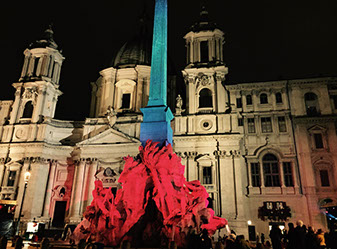
1. The Area
Piazza Navona is located on the site of the Stadium of Domitian, built in the 1st century AD. Today the piazza follows the form of the open space of the stadium. The buildings around the square stand on the terrace of the old “cavea”, which could seat over 30,000 spectators. The ancient Romans came here to watch the agones (“games”) and so it was known as Circus Agonalis (“competition arena”). It is believed that over time the name changed to in avone to navone and eventually to navona, which means "big ship" in Italian, probably helped by the resemblance in shape.
In the 1600's Pope Innocent X started a tradition of covering the drains of the three fountains on Saturdays and Sundays in August, to allow people to enjoy the pooled water. It became known as "Lake of Piazza Navona". This tradition lasted for two centuries until 1866 when Pius IX put an end to the summer fun.
During its history, the Navona has been host to athletic games, theatrical events, major displays and demonstrations, and still is the favourite haunt of gypsies, bands, mime artistes, painters and the ever-present ‘selfie stick’ sellers. Around the piazza itself are many bars and restaurants of variable quality, all catering for tourists. However, a quick excursion into the surrounding streets, particularly on the western side along the Via Governo Veccio, will reward you with restaurants, bars and shops with a much more local outlook.
 The Navona is dominated by the central Fontana dei Quattro Fiumi or “Fountain of the Four Rivers” by Bernini, standing opposite the church of Saint Agnese in Agone by Borromini, Bernini’s great architectural rival. Of course, this church and the piazza were central to the Dan Brown “Da Vinci Code” and "Angels and Demons" nonsense, so try not to follow the tourists intent on identifying all the ‘clues’.
The Navona is dominated by the central Fontana dei Quattro Fiumi or “Fountain of the Four Rivers” by Bernini, standing opposite the church of Saint Agnese in Agone by Borromini, Bernini’s great architectural rival. Of course, this church and the piazza were central to the Dan Brown “Da Vinci Code” and "Angels and Demons" nonsense, so try not to follow the tourists intent on identifying all the ‘clues’.
See the "Fountains" link above for more detail on this fountain.

There used to be a huge Christmas Fair here in December through mid-January, however there has been a crackdown on the stalls selling everything from nativity scenes to fairy-floss, and now only a few remain.

While the overall mood of the Navona is Baroque, there is one Renaissance remnant, the Church of Nostra Signora del Sacro Curore, "Our Lady of the Sacred Heart", with its plain exterior towards the southern end.

The major architectural building is the Baroque church of Sant' Agnese in Agone. Originally the chapel of the Pamphilj family (with the palace next door to its left), the design was first put forward by brothers Carlo and Girolamo Rainaldi, however they soon fell to infighting and Francesco Borromini (the Pope’s favourite at the time) completed the job in 1653.
At the southern end of the Navona is the imposing 18th century Palazzo Braschi. This is actually the rear of the building, with its front being on Piazza San Pantaleo against the busy Corso Vittorio Emanuele II. It is now part of the "Museum of Rome" with an array of ancient statues, however it is perhaps more infamously known as the headquarters of Mussolini's fascist Party during WWII.
On the links at the top of the page I have looked at the fountains, especially Bernini's 'Four Rivers', the Pamphilj Palace, a short piece on the Borromini/Bernini rivalry and a bit bout the surrounding area.

The Piazza Navona
... back to top of page

